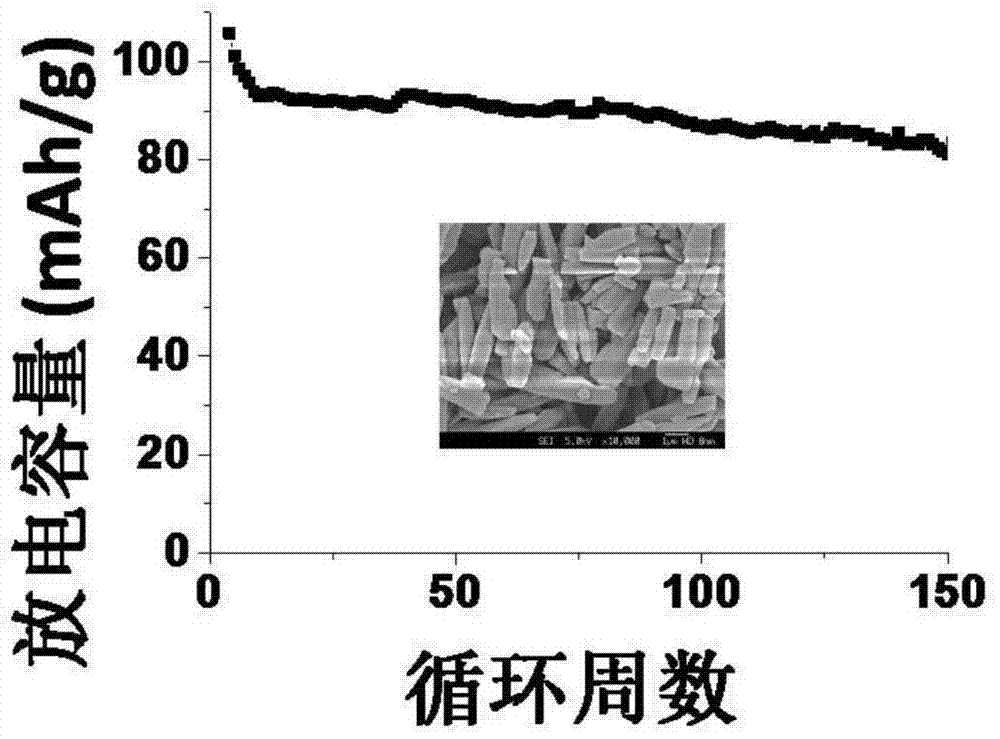Lithium ion secondary battery positive electrode materials of aromatic heterocyclic ketone compounds
A technology for secondary batteries and positive electrode materials, applied in secondary batteries, battery electrodes, non-aqueous electrolyte batteries, etc., can solve problems such as limited application fields and low capacity, and achieve good cycle stability, easy preparation, and structure. rich effects
- Summary
- Abstract
- Description
- Claims
- Application Information
AI Technical Summary
Problems solved by technology
Method used
Image
Examples
Embodiment 1
[0078] Example 1, using quinacridone violet (micron-sized rod-shaped particles) as the positive electrode material to test the performance of lithium-ion secondary batteries: 60 mg of quinacridone as the positive electrode material, 30 mg of carbon black and 10 mg of polybias Vinyl fluoride (PVDF) mixed, after adding enough N-methylpyrrolidone, and then coated on aluminum foil. The coated electrodes were placed in a vacuum oven and dried at 373K for 12 hours. Finally, the electrodes are cut with a tablet machine. In a glove box filled with argon, use the electrode sheet as the positive electrode, polyethylene as the diaphragm, lithium hexafluorophosphate / dimethyl carbonate as the electrolyte (1mol / L), and the lithium sheet as the negative electrode to assemble a lithium-ion secondary battery.
[0079] The battery is charged and discharged at a constant current under the condition of a current density of 50mA / g, and the discharge voltage range is 1.5-4.5V. The cycle discharge...
Embodiment 2
[0081] Example 2, using diindoloquinacridone (nano-sized powder particles) as the positive electrode material to test the performance of lithium-ion secondary batteries: 60 mg of diindoloquinacridone as the positive electrode material, 30 mg Carbon black and 10 mg of polyvinylidene fluoride (PVDF) were mixed, after adding a sufficient amount of N-methylpyrrolidone, and then coated on aluminum foil. The coated electrodes were placed in a vacuum oven and dried at 373K for 12 hours. Finally, the electrodes are cut with a tablet machine. In a glove box filled with argon, use the electrode sheet as the positive electrode, polyethylene as the diaphragm, lithium hexafluorophosphate / dimethyl carbonate as the electrolyte (1mol / L), and the lithium sheet as the negative electrode to assemble a lithium-ion secondary battery.
[0082] The battery is charged and discharged at a constant current under the condition of a current density of 50mA / g, and the discharge voltage range is 1.5-4.5V....
Embodiment 3
[0084] Embodiment 3, use quinacridone quinone powder as positive electrode material to carry out the test of lithium ion secondary battery performance: 60 mg quinacridone quinone is used as positive electrode material, 30 mg carbon black and 10 mg polyvinylidene fluoride (PVDF) Mix, add enough N-methylpyrrolidone, and spread on aluminum foil. The coated electrodes were placed in a vacuum oven and dried at 373K for 12 hours. Finally, the electrodes are cut with a tablet machine. In a glove box filled with argon, use the electrode sheet as the positive electrode, polyethylene as the diaphragm, lithium hexafluorophosphate / dimethyl carbonate as the electrolyte (1mol / L), and the lithium sheet as the negative electrode to assemble a lithium-ion secondary battery.
[0085] The battery is charged and discharged at a constant current under the condition of a current density of 50mA / g, and the discharge voltage range is 1.5-4.5V; the cycle discharge capacity retention curve of the batt...
PUM
 Login to View More
Login to View More Abstract
Description
Claims
Application Information
 Login to View More
Login to View More - R&D
- Intellectual Property
- Life Sciences
- Materials
- Tech Scout
- Unparalleled Data Quality
- Higher Quality Content
- 60% Fewer Hallucinations
Browse by: Latest US Patents, China's latest patents, Technical Efficacy Thesaurus, Application Domain, Technology Topic, Popular Technical Reports.
© 2025 PatSnap. All rights reserved.Legal|Privacy policy|Modern Slavery Act Transparency Statement|Sitemap|About US| Contact US: help@patsnap.com



